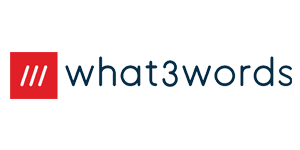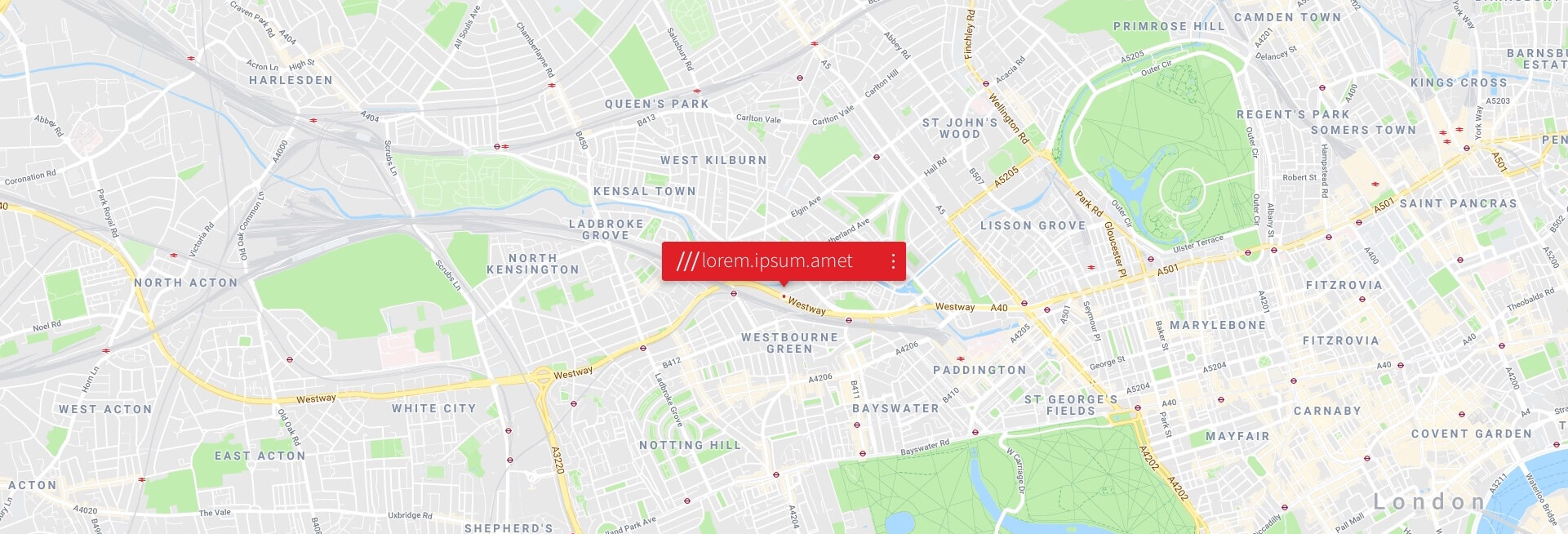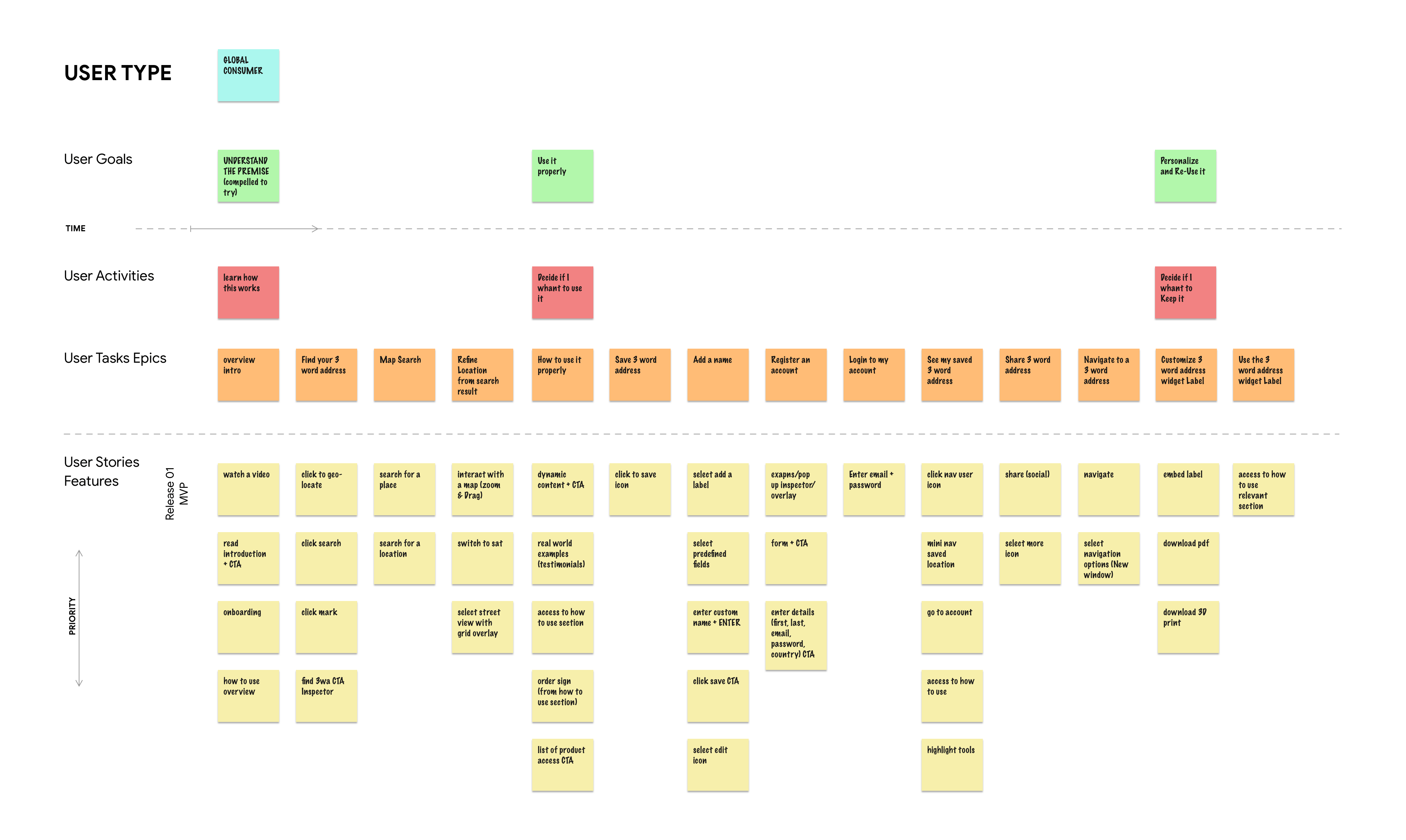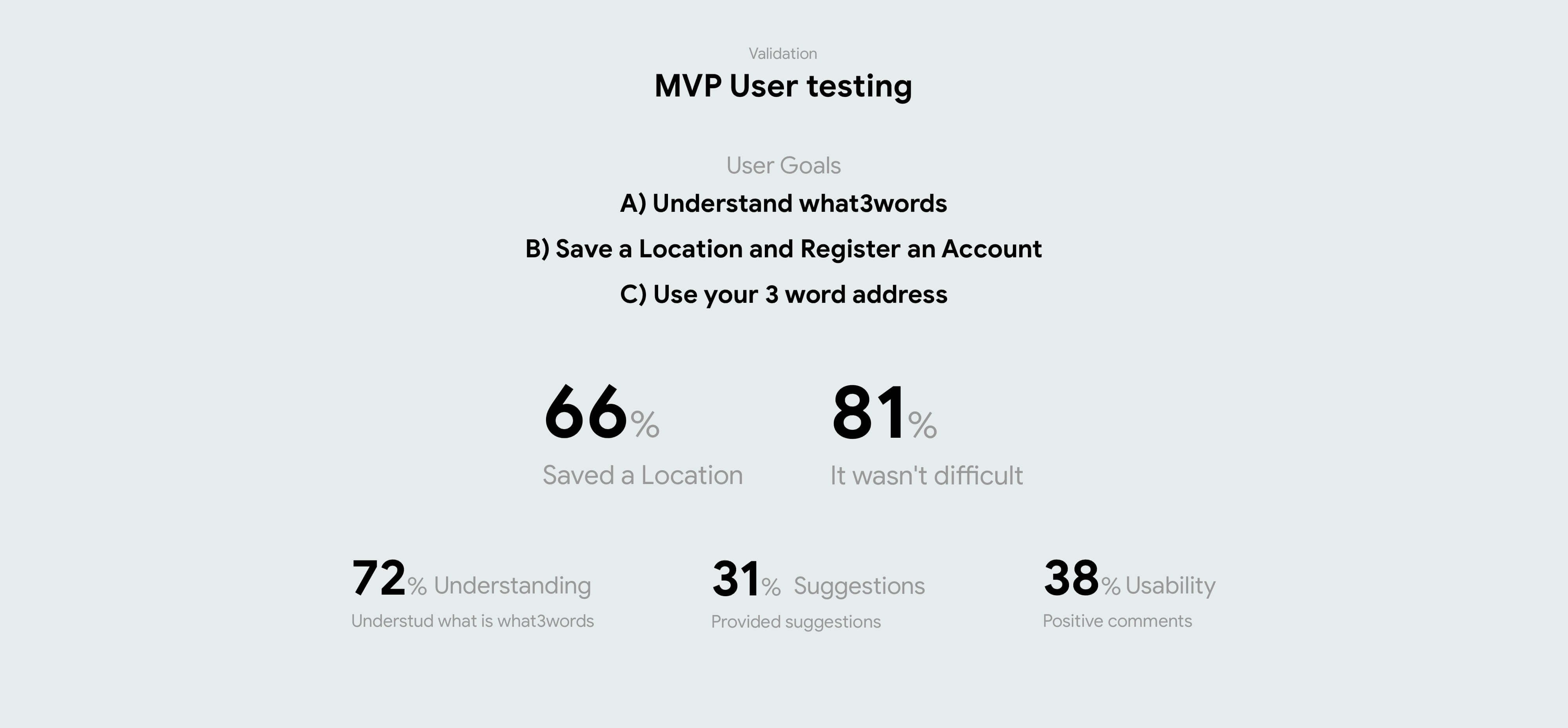what3words Map App
Helps everyone talk about everywhere

Client
what3words Ltd
Addressing & geocoding System
Year
2018
London, UK
Case Study Overview
what3words given every 3m x 3m in the world a unique 3 word address.
«”…This simple and accurate way to talk about location makes it easier to meet up with friends, discover and tell others about amazing places, and explore the world without getting lost. You’ll see 3 word addresses displayed by hotels, restaurants, travel guides and websites. They can be used in 20+ languages and are much simpler to remember, use and communicate than regular addresses. They’re also far more accurate and reliable.”»
As the Lead Product Designer at what3words, I poured my passion and expertise into driving the company's growth and making a meaningful impact on people's lives. From the ground up, I established an efficient UX & Product Design workflow, crafted a solid UX-Strategy, and built a React-based Design System that served as a foundation for our products.
I led the charge on designing multiple products and successfully grew a UXD team of four permanent members and a group of freelancers. Throughout my tenure, I worked closely with executives, stakeholders, and business partners to shape our entire product range.
Collaboration was key to our success, and I worked hand-in-hand with our engineers to integrate Google Maps using APIs across most of our products. Together, we delivered exceptional user experiences that elevated what3words' position in the marketplace.
Some information and details are excluded due to confidentiality reasons.
Managing the project
UX & Product Design work-flow

Problem & Opportunity
«”75% of the world suffers from poor addressing or none at all. The other 25% still lacks universal coverage. Whilst improvements have been made in mapping and navigation, defining exactly where “there” is remains a big issue.
The UN estimates that 4 billion people lack a reliable way to address their homes. They struggle to open bank accounts, register a birth or access electricity or water supplies, becoming invisible to the state.”»
At what3words, our products rely heavily on integrating with the Google Maps API, providing our users with the core map functionalities and Google's well-known and trusted visual aesthetic. One challenge we faced was avoiding the perception of being just another Google Maps clone, and instead, highlighting our unique value proposition as a location/addressing system, rather than a pure navigation platform.
To tackle this issue, we engaged in extensive discussions around how we could differentiate our map view from the standard Google Maps view and convey our distinct identity as a location-based service. By leveraging design elements such as color, typography, and iconography, we created a custom look and feel that communicated our brand's identity and value proposition while still providing a familiar and intuitive user experience.
Main challenge
Our main challenge is to make people's lives easier by providing a simple and accurate way for everyone to communicate about any location on the planet. Our innovative addressing system enables us to endorse, educate, and enable our users, empowering them to navigate the world with ease.
We are committed to helping people worldwide find their 3-word address and communicate it effectively, regardless of their location. Our user education initiatives and tools enable people to understand the benefits of our addressing system and leverage it to their advantage.
By breaking down communication barriers and streamlining location sharing, we are helping individuals and businesses worldwide to thrive. At what3words, we believe that location should never be a barrier to communication, and we are dedicated to making location-based communication accessible to everyone, everywhere.
My role
Lead UX & Product Designer
Solution
We have developed a comprehensive solution to make location-based communication effortless and intuitive for our users. Our focus is on providing a new vision of how users can interact with the map view upon their first use of the platform.
We have carefully considered when and how to first present the 3-word grid to the user, ensuring that it is intuitive and easy to use. We have also designed the interface to enable users to quickly and easily switch to satellite view when refining their exact location. We encourage users to save their 3-word address and promote its use as a simple and efficient way to communicate their location.
Our user-centric approach focuses on making location-based communication as effortless as possible, while still providing the accuracy and precision that users require. By providing a comprehensive solution that includes education and training on our platform, we empower our users to take full advantage of our addressing system and enhance their daily lives.
The Project
Approach
Product Audit
At the start of the project, my focus was to audit the current addressing systems and understand how people were struggling to make them work. Through on-site research, it became clear that addressing around the world was unsuitable for everyday needs. Street addresses were often inaccurate or ambiguous, road names were repetitive, and many homes and businesses were located far from the center of their postcode. Furthermore, much of the world simply wasn't addressed, from informal settlements to parks and other public spaces.
«”Street addresses can be inaccurate or ambiguous. Road names are repetitive. Homes and businesses are often located far from the center of their post code. And much of the world simply isn’t addressed – from informal settlements to the park where you’ve planned to meet friends, or the precise location where you’re waiting for the cab to collect you. ”»
In response to these findings, I organized internal workshops to analyze data and understand user problems. We focused on the value proposition of the business, identifying how we could create gains to help users solve their problems and complete their key tasks.
Research
One key finding was how different types of users around the world interact with maps. We discovered that many users had never been in touch with a map before, highlighting the importance of providing a user-friendly map experience. The critical point was the lack of mass adoption and the difficulty of locating your front door by looking at a map.
As a result of our research, we identified that the most important thing to start with was improving the map experience, providing a better understanding of the what3words technology and grid system, and helping users interact with the map to find their exact location. Our goal was to make location-based communication easy and accessible for everyone, regardless of their level of map literacy.

MAP Zoom levels discovery and grid concept
The following list shows the approximate level of detail you can expect to see at each zoom level:
1: World
5: Landmass/continent
10: City
15: Streets
19: 3 word address grids
20: Buildings



Challenge
Design functional and engaging Map experience
API Grid and 3 word address mark as Map overlay
«”The what3words RESTful API gives you programmatic access to convert a 3 word address to coordinates (forward geocoding), to convert coordinates to a 3 word address (reverse geocoding), to obtain suggestions based on a full or partial 3 word address (AutoSuggest, Voice AutoSuggest and StandardBlend), to obtain a geographically bounded section of the 3m x 3m what3words grid and to determine the languages that the API currently supports.”»


3 word address Mark interactions
The evolution of the Mark during the process of identifying, saving, and labeling a 3 word address is an important aspect of the user experience. We wanted to ensure that the Mark's appearance and functionality evolved seamlessly, depending on the user's actions and the zoom level of the map.
Initially, when a user identifies a 3 word address, the Mark appears as an unsaved marker on the map. As the user interacts with the map and saves the 3 word address, the Mark evolves to a saved marker, indicating that the location has been saved. As the user zooms in on the map, the Mark evolves further, displaying more detailed information about the location.
When the user chooses to label the location with a custom name, the Mark evolves again, displaying the label text on the map. The labeled Mark also includes additional information about the location, such as the nearest road and the city or town name.
To ensure a smooth and intuitive user experience, we designed the Mark's appearance and functionality to evolve seamlessly as the user interacts with the map. This allows users to easily identify, save, and label their 3 word addresses, regardless of their level of map literacy.


Multilingual system, fonts and dynamic 3 word address text resizing
To ensure that our multilingual system accommodates users worldwide, we made sure that 3 word addresses are available in a range of languages, with more languages being added regularly. This means that users can use their native language or the language of the country they’re in, which helps make the system more accessible to everyone.
However, we also recognized that different languages may require different amounts of characters and varying font sizes, which could make the text appear differently in different languages. To address this issue, we adopted a dynamic text resizing approach that adjusts the font size based on the amount of text in a fixed or fluid space.
This ensures that the text is always readable and visually appealing, regardless of the language or the length of the 3 word address. This approach makes the font size responsive based on the dynamic amount of characters, allowing the text to fit neatly and legibly into the designated space.
By implementing this dynamic text resizing approach, we've ensured that our system is inclusive and accessible to everyone, regardless of their language, and that users can rely on the system to accurately and clearly identify their 3 word address.

UX Strategy
Story Mapping: Task models and Scenarios

Search Scenarios
Search 3 Word Address - When a user enters a 3 word address search query, the system provides 3 search results. However, a 3 word address result is only displayed once the user has entered the first letter of the third word (e.g. Index.home.r). This approach helps the user to identify and select their desired location more accurately.
Search Location or Place - The search feature allows users to search for a specific location (3 word address) or place. The search results for places include additional information such as the distance from the user's current location, if location permission is granted. This helps users to better understand the results and make an informed decision.

Search empty-state
Empty state once the search bar has been activated is providing an overview about the difference to search a place or search a 3 word address location.
Search a place
Search results always provide the user with 5 results. User has given What3Words access to their location. Distance to be displayed in local system. Imperial/metric.




Refine Scenario
The app shows your current 3 word address or the 3 word address of your searched location. To accurately move the mark to the desired location, the user can switch to satellite mode and visually identify the exact location. The highlight dotted grid is based on the main grid and consists of 5 levels of increasing density, each square being 3 meters by 3 meters in size for precise referencing. To move the mark, the user can drag the map to position the square on the desired location and save the 3 word address.

Save Scenarios
Once the user saves a 3 word address location, they have the ability to manage their saved locations in their account. They can edit or delete any saved locations as well as add new ones. This feature allows users to quickly access their favorite locations and helps to make the app more personalized and user-friendly.
In addition, the app can also provide the user with the ability to share their saved locations with others. This can be particularly useful for sharing a meeting location with colleagues or friends.
To further incentivize users to save their favorite locations, the app can also offer rewards or special promotions for frequent use of the save feature. For example, users can earn points towards discounts or other perks for saving a certain number of locations or sharing their saved locations with others.



Quick access to Saved Location
At the bottom left of the screen, you'll find a section dedicated to your saved locations. To make it easy to find your most important addresses, we've placed your labelled locations at the top of the list. You can even rearrange them by holding down and dragging them up or down. Below your labelled locations, you'll find a chronological list of all the addresses you've saved without a label.

The what3words app helps you find, share and navigate to any precise location.
All the essential tools to use a 3 word address

I've used Principles in my process to communicate or validate concepts.
High-fidelity Prototype
Learnings, results and output
Overall, users have found the app to be highly accessible and user-friendly, resulting in strong growth and positive feedback. However, some bugs, particularly on the Android platform, have negatively impacted the app's usability.
To improve the app, users have suggested the need for more information on how the app works so that they can understand it better and share it with others. They also want to learn about the app's features and how other people use it to get the most out of it. Users also expressed interest in knowing where and how to use the app in their daily lives and learn from others' experiences.
Additionally, users have shown a willingness to give feedback, participate in beta testing, fill out surveys, help other users, and write reviews to share their experiences. They also want to spread the word to local businesses to improve their community and sign up for newsletters and social channels to stay updated on the app's progress.
Use the app to:
- Navigate to any location in the world, even where traditional street addresses are unavailable
- Share precise picnic or festival locations with friends
- Easily locate your tent or parking spot at events
- Direct your taxi or delivery driver to the exact location you need
- Plan and share hiking or off-roading routes with customizable waypoints
- Find your parked car with ease
- Direct deliveries to a specific entrance or location
Key App Features:
- Compatible with popular navigation and messaging apps, such as Google Maps and Apple Maps
- Search for locations using 3 word addresses or traditional street addresses
- Save your frequently visited locations for easy access
- Autocomplete feature helps prevent errors in typing 3 word addresses
- Available in 20+ languages for global use
- Access offline navigation with compass mode for when you don't have internet connectivity
Download the app
«”You’ll see 3 word addresses displayed by hotels, restaurants, travel guides and websites. They can be used in 20+ languages and are much simpler to remember, use and communicate than regular addresses. They’re also far more accurate and reliable.”»

Web Responsive Map
A version of the Map is available on web to ensure the best Cross platform experience. To discover more take a look to the next case study.

My own vision, ideas and long term strategy
While my own vision, ideas, and strategies may not necessarily reflect the business vision, I believe it's important to provide an overview of how I think this product could evolve and improve in the long term.
To begin, I suggest engaging users through marketing and tutorials to build a relationship. We could showcase case studies about how partners adopted 3WA and allow users to discover stories about locations through user-generated content. This would encourage users to be part of a community and enable an empowerment proposition.
To support this vision, it would be necessary to let users create explorable content that is visible on the map. Lists of interests with private and public saved locations would be essential to support their privacy.
One idea I have is to link the 3wordPhoto App, allowing users to link their photos to their account and decide whether or not to publicly show their content to other users.
Furthermore, we could create a blockchain system based on crowdsourced information, enabling users to share real-time information and content about locations by simply sharing information about accidents, dangers, blocked roads, hidden gems, and other types of locations with the community.
In the future, I believe that IA, AR, and VR will play a key role in making the user experience even more immersive and exciting than we can currently imagine.
Tags
#Travel #Tourism #Voice #Navigation #PostalServices, #Automotive & #Mobility #Events #emergency-services. #Geolocation #GoogleMaps #API #wha3words #Grid-System #UX #ProductDesign #Interactions #ValueProposition
Fair dealing Disclaimer
Sections 29 and 30 of the Copyright, Designs and Patents Act 1988
I've written this Case Study for purposes such as research and private study, criticism or review, or news reporting. I’ve used part of the copy from the author website (what3words.com) that you can see under the quotations «”…”»








































